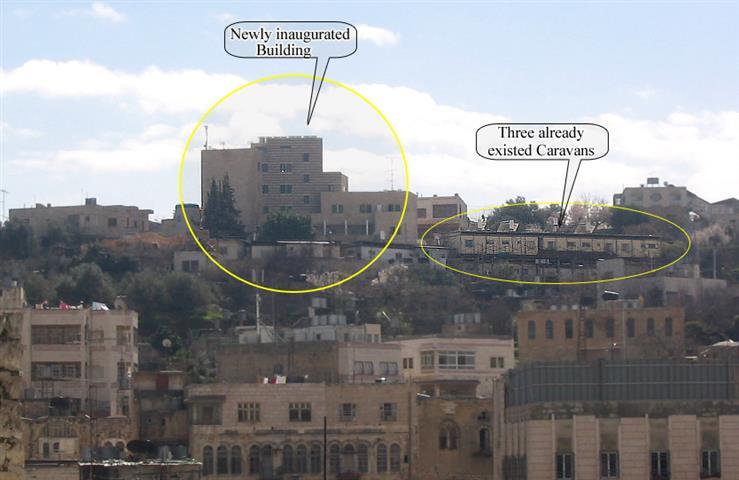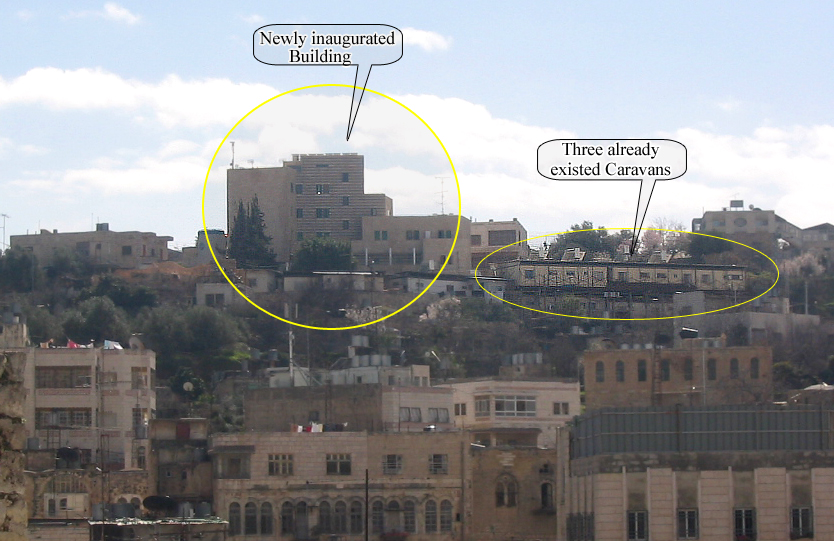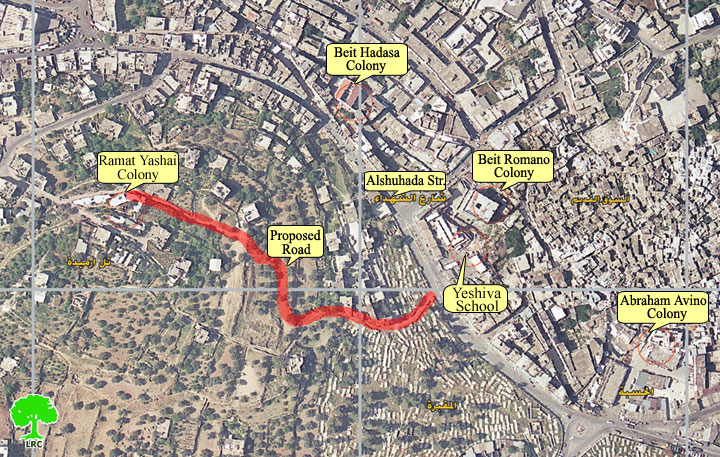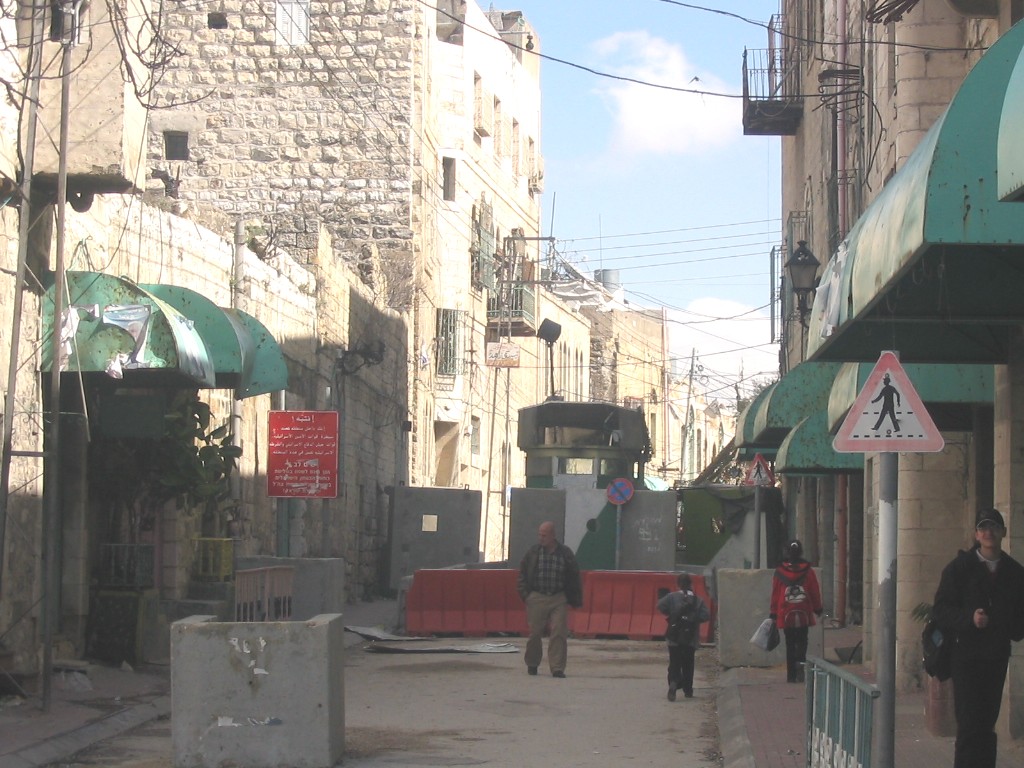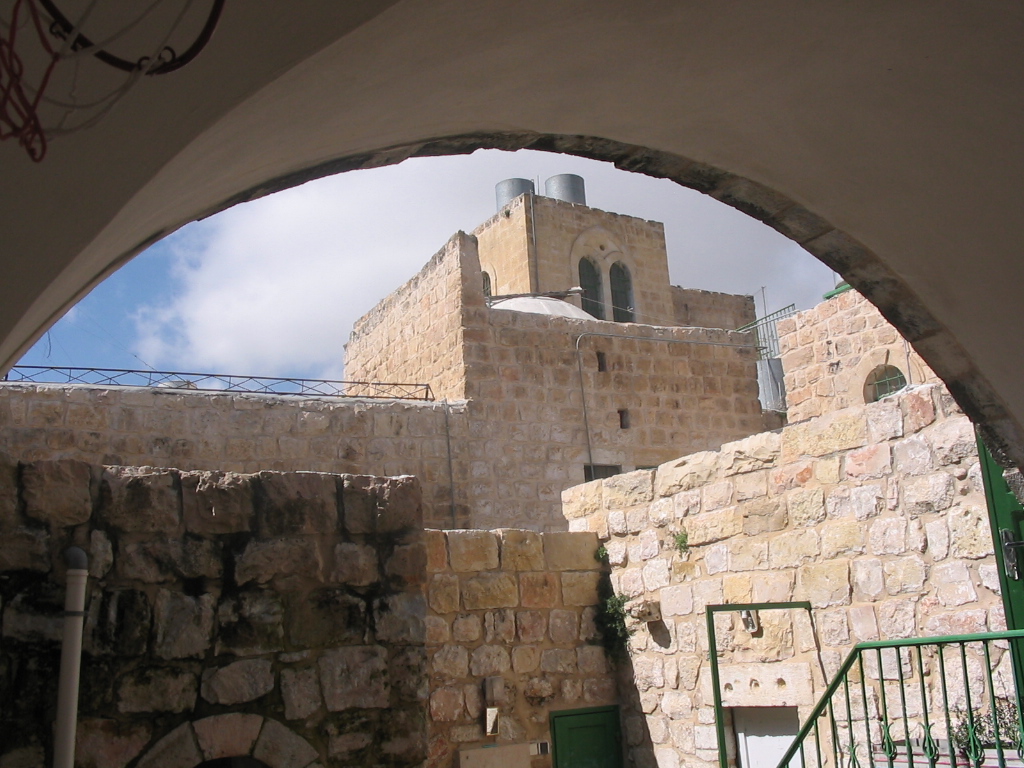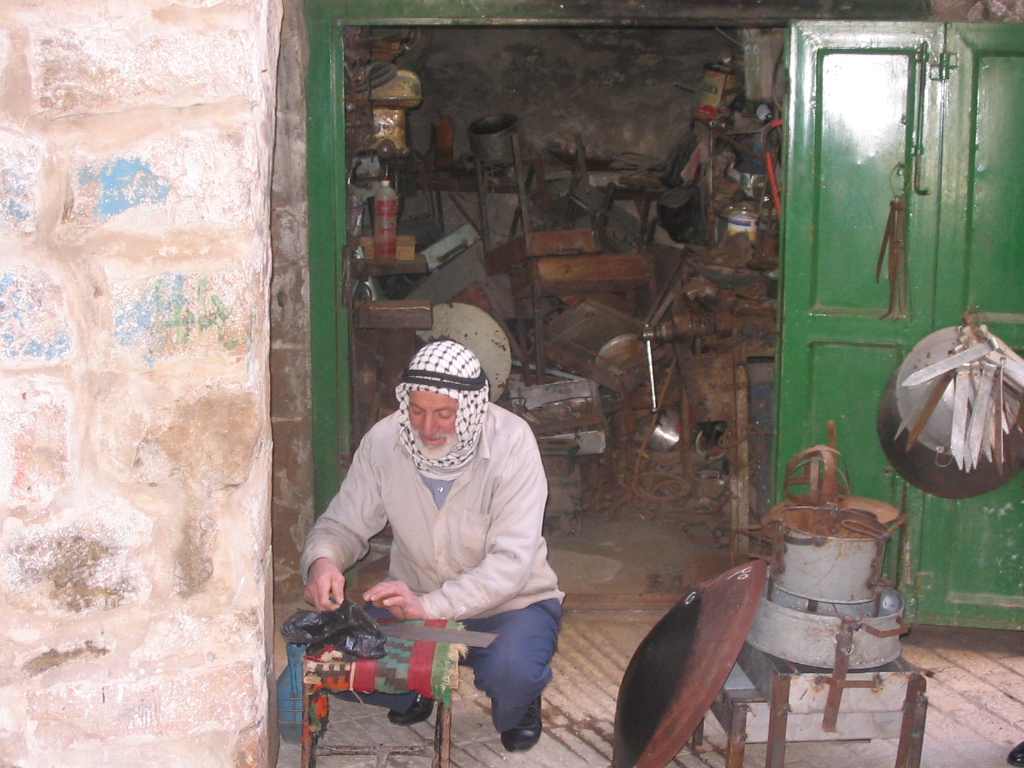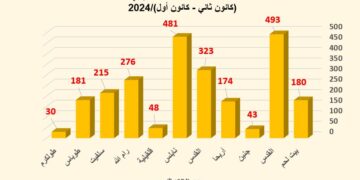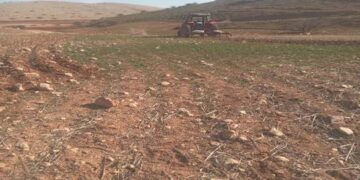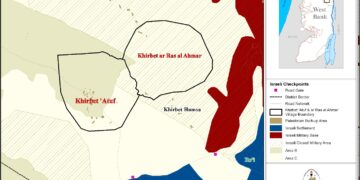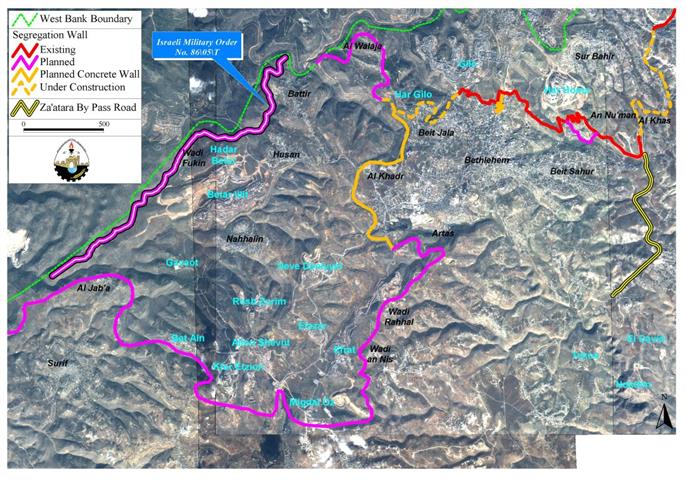On May 7, 2004, thousands of Israeli settlers rallied in the streets of occupied Hebron old city in a provocative show to inaugurate a multi storey residential building. The residential building consists of five floors (thirteen apartments) and is located in Tel Rumaida ancient site, in the western side of the old city.
Thirteen Jewish families were brought to live in the building amidst thousands of Palestinian citizens who expressed their dissatisfaction over settlers' actions in the city and hold the Israeli government the total responsibility.
Successive Israeli governments have encouraged the Israeli expansion inside Hebron old city. The construction of the aforementioned building on top of this archeological site was approved in year 2000 by the Israeli Minister of housing and construction that time, Benjamin Ben Eliazer.
( Photo 1: newly inaugurated residential building in Tel Rumaida)
( Photo courtesy of LRC )
Large Colonial plan
The construction of these apartments came as part of a large colonial plan supervised by a Jewish organization named 'The Organization for the development of Jewish quarters in Hebron'. This plan has been in force since the early days of the Israeli occupation of Hebron in 1967 and encompasses the following stages:
-
The first stage: the establishment of ' Abraham Avino' settlement in the old vegetable market near the Ibrahimi mosque. Once inaugurated, 7 Jewish families were brought in. Today, it houses dozens of Jewish families.
-
The second stage: the occupation of Usama Ben Mungiz School along with the old bus station in Al Shuhada Street According to the plan, this site was named Beit Romano and a number of housing units, kindergartens, a night club and swimming pools are currently under construction over. The bus station was turned into a Jewish school named Yeshiva after mobile homes were brought in.
-
The third stage includes the construction of a multi story residential building and a synagogue over the already occupied Dapoyia compound 'Beit Hadasa'. This stage was completed few years ago.
-
The fourth stage has included the construction and inauguration of the above mentioned building in Tel Rumaida area under the name of 'Ramat Yashai'. The 13 permanent apartments were added to three mobile homes which were introduced to the site in the year 1984.
The number of Jewish settlers in Hebron old city mounts to 500, protected by more than 1500 Israeli soldiers; while the number of Palestinian citizens living in the Old City is about 45000.
Hostage taking, state terror and repression
Harsh measures were taken by the Israeli forces in Hebron old city to pave the way for holding the Jewish festivities and to facilitate the inauguration of the residential building in Tel Rumaida. Palestinian citizens, particularly those who live close to the Jewish colonial posts were held hostages inside their homes for long hours. The family of Mr. Mohammed Hamid Abu 'Ieisha (9 family members) who live near the fence of ' Ramat Yashai' settlement were imprisoned in one single room for 8 hours and were not allowed to move or make any phone calls or even use the toilet under the pretext of securing the lives of Jewish settlers who were celebrating out side. Walid, a five years young boy from Abu 'Ieisha family, was hit by an Israeli soldier during hostage taking.
Since the early hours of the day (April 26, 2005), Israeli settlers and soldiers started to hang Israeli flags and racist slogans along Al Shuhada road which leads to Tel Rumaida site. Large numbers of Israeli military personnel took positions in the city. Earlier, Israeli press reports had indicated that thousands of settlers and their supporters rush to Hebron Old City to take part in the Jewish 'Pesah' to be held in the vicinity of the Ibrahimi mosque compound and the inauguration of Tel Rumaida building.
( Photo 3: The entrance to Shuhada road )
(Photo courtesy of LRC) )(Photo courtesy of
In an interview with Mr. Mufeed ash Sharabati whose family lives near ' Beit Hadasa', said that the Israeli army informed all the Palestinian families living in the area not to move out of their homes from 7 AM to 7 PM and thus prevented school children from reaching their schools.
Meanwhile, the Israeli forces closed with barricades all the roads leading to Ibrahimi mosque paralyzing the Palestinian movement in and out of the mosque and creating a state of curfew in the area. Shopkeepers were, also, forced to shut down, while dozens of Israeli soldiers climbed roofs of Palestinian houses overlooking the market area and the old quarters. Moreover, a number of Palestinian houses were searched and their contents were destroyed. Dozens of Palestinian pedestrians, especially students from the Polytechnic and Hebron universities were detained in streets for long hours.
(Photo 4 and 5: An iron gate blocking the entrance to the Ibrihimi mosque)
(Photos courtesy of LRC) and : An iron gate blocking the entrance to the Ibrihimi mosque) (Photos courtesy of LRC)
Historical background of Tel Rumaida
Hebron city has been built originally around Tel Rumaida area. According to archeological excavations carried out by several missions, Tel Rumaida area is considered to be an archeological site that witnessed many civilizations throughout history. It is dated back to the Bronze period, the Iron period, the Roman period, the Byzantine period and the Islamic period.
Canaanites had built their political capital in Tel Rumeida more than 5500 years ago. Ein Al Jadeda, located in the eastern side of Tel Rumeida area used to be the main water resource for Hebron. Hebronites had planted and later fertilized Hebron valley (Wadi Al Khalil Al Khasib) in that area.
Many archeological excavations had taken place in Tel Rumaida area. The first was during the period of 1963 and 1966 by the American mission under the supervision of archeologist Philip Hammond. Then, later excavations took place in years 1982, 1985, 1986 and 1999 by the Israeli archeological missions.
All of the excavations and diggings have emphasized on the historical importance of Tel Rumeida and have approved the fact that the area had witnessed several civilizations.
Tel Rumaida area is considered an archeological site since 1944, when the British Mandate listed it within the historical sites of Palestine. Thereafter, the Jordanian government stressed on that during its control of the West Bank until 1967.
Following the Israeli occupation of the West Bank and Gaza Strip in 1967, the Israeli government issued a military order stating that Tel Rumeida is an archeological site and therefore prevented any constructional works that might change its historical characteristics. Meanwhile, the Israeli settlement strategy has allowed a group of settlers in 1984 to settle three mobile homes (caravans) over that archeological site.
Last February (February 2005), the Israeli army decided to open a new colonial road to link Tel Rumeida with the other Jewish settlements in the city. For related information, click here.
(Photo 6: an old residential compound ( Housh in Arabic) inside the old city of Hebron)
(Photo 7: A Palestinian old man working in his shop inside the old city)
(Photo courtesy of LRC)
Creating this road will lead to the demolition of historical houses and Graves, uprooting of long-lived olive trees and destruction of ancient monuments in the area.
Conclusion:-
The inauguration of this building, along with many other Israeli violations committed by the Israeli forces and settlers in the city, is a flagrant violation of Hebron Protocol, signed between the Palestinian and the Israeli sides in January, 1997 as part of the peace agreements.
This act is, also, a clear violation of pertinent intentional covenants and Human Rights charters and declarations, including the Geneva Convention on the Protection of Civilians at the Time of War, Article 39, which stipulates that 'The occupying power should not transfer part of its residents to the occupied territories'.
Prepared by
The Land Research Center
LRC


